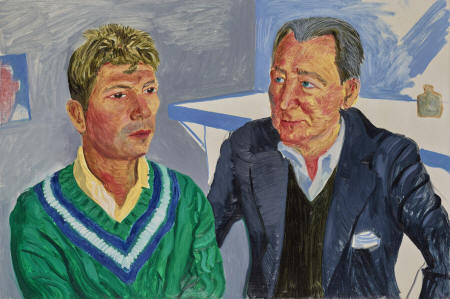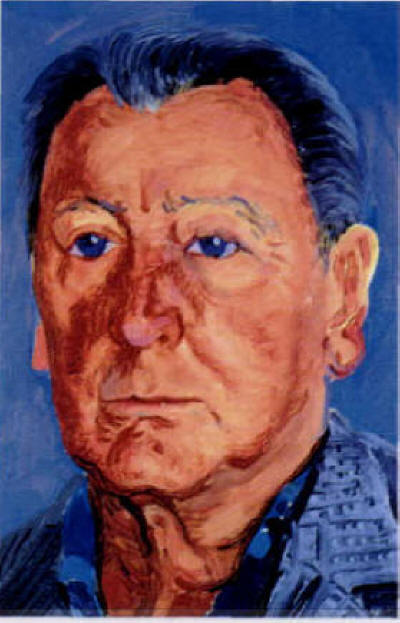Queer Places:
The Old Cottage, Warcop, Appleby-in-Westmorland CA16 6PH, UK
University of Oxford, Oxford, Oxfordshire OX1 3PA
 (Christopher) Richard Sandford Buckle, CBE (6 August 1916 – 12 October 2001), was a lifelong English devotee of ballet, and a well-known ballet critic. He founded the magazine Ballet in 1939.
He was a close friend of Simon Fleet, for
whom gave the eulogy at his funeral.
(Christopher) Richard Sandford Buckle, CBE (6 August 1916 – 12 October 2001), was a lifelong English devotee of ballet, and a well-known ballet critic. He founded the magazine Ballet in 1939.
He was a close friend of Simon Fleet, for
whom gave the eulogy at his funeral.
Christopher Richard Sandford Buckle was the only son of Lieutenant-Colonel Christopher Reginald Galbraith Buckle, DSO, MC, of the Northamptonshire Regiment,[1][2][3] and his wife Rose, daughter of Francis Marmaduke Henry Sandford (descended from the Dukes of Portland and Barons Brooke) and his wife Constance Georgina Craven, great-granddaughter of the soldier William Craven, 1st Earl of Craven and maternal granddaughter of the naval commander and politician Charles Philip Yorke, 4th Earl of Hardwicke.[4] They lived at the Old Cottage, Warcop, Cumberland.[5]
The Buckle family consisted of minor gentry descended from Sir Cuthbert Buckle, Lord Mayor of London in 1593–1594. Buckle's uncle (married to his father's sister) was the clergyman Eric Graham.[6][7] His father was killed in 1918 – Buckle was raised (and doted upon) by his mother and a number of female relations, including his paternal grandmother, Lily Buckle of Eden Gate, Warcop.[5] Though raised in "genteel poverty", Buckle was interested in his extensive network of relations (some of them high aristocracy) and formed some close relationships with them. He contributed some genealogy to "U and Non-U Revisited" in 1978.[5] He was educated at Marlborough College, then Balliol College, Oxford to read modern languages, where he failed to obtain a scholarship and left after a year.[8][9] He then attended the Heatherley School of Fine Art in London for a short time, having developed an interest in ballet,[8] to which he dedicated himself, although his family had hoped he would pursue a stable career in banking – or even in the stage design he had studied.[10]

Duffen and Richard Buckle (Older Gentleman with Young Gentleman), 1989, by
David Hockney

Richard Buckle by David Hockney
Buckle founded the magazine Ballet in 1939, and revived it after the war, in which he served with the Scots Guards, being mentioned in despatches in 1944 during the Italy campaign. Between 1948 and 1955 he was ballet critic for The Observer. He organised a number of successful exhibitions, notably one in 1954 on the life and work of
Sergei Diaghilev, first at the Edinburgh Festival and then at Forbes House in London, and the quatercentenary Shakespeare exhibition at Stratford-upon-Avon in 1964–1965. His publications include comprehensive biographies of
Vaslav Nijinsky (1971) and Diaghilev (1979).
Buckle was a pallbearer at the funeral of of Nijinsky. According to Buckle, ‘Serge Lifar was (by his own admission) sexless, feeling
no physical desire either for men or women, although he aroused the desire and
love of both’. In his memoirs, the American dancer and choreographer
Lincoln Kirstein remembers
having cut out and saved a picture in Vanity Fair, an etching by Troy Kinney
of Vaslav Nijinsky
in his costume for Les Sylphides. Kirstein rather coyly says of it, ‘this
etching became an icon to which I constantly referred as the sum of masculine
possibility’. It later turned out, when he met them, that both
Osbert Sitwell and
Richard Buckle remembered keeping
the same clipping; Kirstein is naïvely surprised by this.
Buckle wrote a book about Katherine Dunham’s dance group with photographs by
Roger Wood. The photographer opened a studio in Bayswater, west London, specialising in ballet in
1948. He was a friend of
Anthony Armstrong-Jones and married rather late (in 1986) and was also a friend of Graham Sutherland,
Lucian Freud and Henry Moore. Dunham and her dancers have been linked to appreciation of black men by white gays in several studies, particularly in relation to
John Minton and
Noel Coward, but the black sculptor
Richmond Bathé as well. She had links with the ballet via ‘Cabin in the Sky’, staged by
George Balanchine, in which
all her company were used.
Dickie Buckle is instigator and designer of a number of highly successful exhibitions, orchestrates one on the life and work of Diaghilev. First shown at the Edinburgh Festival it moves to Forbes House in London. It was revolutionary according to Roy Strong in his obituary for Buckle in the Guardian. He described a path “past a tableau of grand ladies at the ballet before 1914, then the beach at Deauville in the 1920s, on through tented rooms hung with chandeliers, each with its separate theme, ending up ascending a huge staircase on which brooded statues of sentries embowered with greenery leading up to the palace of the Sleeping Beauty. One’s ears were filled with the music of the ballet and the air was scented with Diaghilev’s favourite perfume.” The costumes from the Cyril Beaumont collection were placed throughout like disembodied surrealist presences. Buckle utilised an army of talents to realise the settings, including
Cecil Beaton,
David Hockney, Scottish artist
Peter McGinn, Leonard Rosoman, and Nicholas Georgiadis. Between 1954 to 1964
his exhibition staging was hugely innovative. In 1967 at the sale of the
surviving Diaghilev scenery and costumes (Serge Grigoriev collection), he was
instrumental in the purchase of the Picasso backcloth to the ballet Le Train
Bleu for the Theatre Museum.
Buckle edited several books, including the autobiography of Lydia Sokolova and the selected diaries of
Cecil Beaton. Richard Buckle was appointed CBE in 1979.
Having begun to suffer from poor health (yet producing some of his best work – the biographies of Nijinsky and Diaghilev – during this period),[8] Buckle left London in 1976 and settled in Wiltshire in an isolated cottage, made more so by the fact that he did not drive. After recovering from a heart attack in 1979, he concentrated on his autobiographical works. He regularly visited his home village of Warcop, Cumbria, in the 1980s, sharing his recollections of the place fifty years earlier.[5]
My published books:


BBACK TO HOME PAGE

 (Christopher) Richard Sandford Buckle, CBE (6 August 1916 – 12 October 2001), was a lifelong English devotee of ballet, and a well-known ballet critic. He founded the magazine Ballet in 1939.
He was a close friend of Simon Fleet, for
whom gave the eulogy at his funeral.
(Christopher) Richard Sandford Buckle, CBE (6 August 1916 – 12 October 2001), was a lifelong English devotee of ballet, and a well-known ballet critic. He founded the magazine Ballet in 1939.
He was a close friend of Simon Fleet, for
whom gave the eulogy at his funeral.


